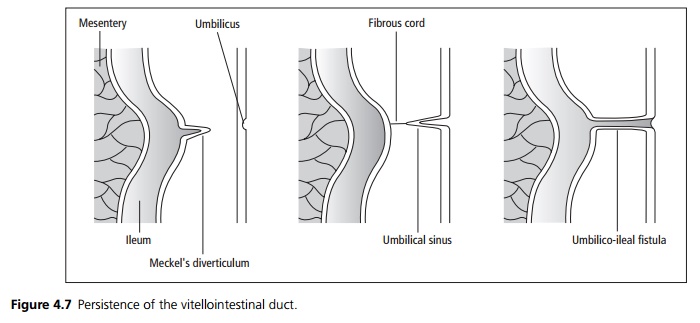Chapter: Medicine and surgery: Gastrointestinal system
Meckel’s diverticulum - Disorders of the small bowel and appendix
Meckel’s diverticulum
Definition
An ileal diverticulum occurring as a result of persistence of part of the vitellointestinal duct.
Incidence
2% of the population, the most common congenital abnormality of the GI tract.
Age
Congenital
Sex
2M > 1F
Aetiology
The vitellointestinal duct runs from the umbilicus to the ileum. By birth the duct has either disappeared or is normally only a small fibrous cord. Persistence of the duct may result in a Meckel’s diverticulum (persistence of the ileal end of the duct), an umbilical sinus (persistence of the umbilical end of the duct) or an umbilical ileal fistula (see Fig. 4.7).

Pathophysiology
The diverticulum arises from the antimesenteric border of the ileum 2 ft from the ileocaecal valve and is on average 2 inches long. Ten per cent of diverticula are joined to the umbilicus by a fibrous cord. Acid secreting gastric mucosa is found in 50% of cases which may result in ulceration of the surrounding mucosa.
Clinical features
Ninety-five per cent of cases are asymptomatic, symptomatic patients present most commonly with bleeding due to ulceration of the adjacent ileum. Intestinal obstruction may result from intussusception of the diverticulum or from a volvulus.
Investigations
Presence of gastric mucosa can be detected by scintiscanning with 99mTc labelled sodium pertechnetate, which is taken up by parietal cells (the Meckel’s scan).
Management
Symptomatic Meckel’s diverticula are excised by wedge resection.
Related Topics